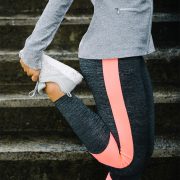The Truth About Stretching
Stretching…if there is one subject that carries constant controversy, it would have to be the discussion of stretching and whether it beneficial to an athlete’s performance program or not.
To those athletes who have endured a substantial injury and/or surgery will attest to the benefits of stretching and how important it is in re-establishing the optimum range of motion with the muscle(s) and surrounding joints. For other athletes, there is a mindset that stretching actually causes more strain on the muscle and even feels like the muscle shortens during stretching. So how can both correct?
To explain both sides of this controversy, let’s begin by looking at the physiology of how muscles move and the associated reflexes associated with range of motion. There are two types of muscle contractions: isotonic and isometric. An isotonic muscle contraction is a voluntary contraction that causes movement. Under the umbrella of isotonic contractions, there are two types of contractions: concentric (where the muscle shortens as it works) and eccentric (where a muscle exerts force while being lengthened by an outside force). An isometric muscle contraction is a voluntary concentric contraction where there is no joint movement and the length of the muscle is unchanged. Please don’t get frustrated with all of these concepts. Instead realize that before you can focus on stretching a muscle, you must first understand how they function so that you can effectively (and without injury) lengthen them for improved range of motion.
Your body is equipped with a stretch reflex known as the myotatic stretch reflex which prevents a muscle from stretching too far and/or too fast protecting the surrounding joint from becoming injured. This stretch reflex is mediated through the muscle spindle cells and is constantly evaluating both the speed and length that muscle is going through. When a muscle lengthens either too far or quickly, the spindle cell is stimulated and reflexively causes the muscle to contract, resisting the lengthening and preventing overstretching of the joint. An additional component to the stretch reflex is a concept known as the Inverse Stretch Reflex. Though this component is beyond the scope of this article, this reflex engages the Golgi tendon organ which monitors the amount of stress being placed on the tendon at the attachment. It is the combination of the myotatic stretch reflex and the inverse stretch reflex that causes the muscle to relax, lengthen and ultimately increase your range of motion.
The Two Types of Stretching
Ballistic stretching (also referred to as dynamic stretching) is completed by using rapid bouncing movements to the isolated muscle. This type of stretching has a tendency to invoke the stretch reflex leaving the muscle shorter than its pre-stretching length. The negative side effect of ballistic stretching is that it creates twice the tension within the isolated muscle and in turn increases the risk of tearing the target muscle(s) due to the fact that the rapid bouncing doesn’t allow enough time for the inverse stretch reflex to be engaged and relax the muscle.
Static stretching occurs when the isolated muscle is lengthened slowly (to inhibit the firing of the stretch reflex) and held in a comfortable range for 15 to 30 seconds. As the stretch is maintained, the tension within the muscle diminishes due to the inverse stretch reflex and the depth of the stretch is increased. This is the range of motion that is advised and taught here at CoachRobb.com.
How to Effectively Increase Your Range of Motion & Reduce Your Risk of Injury Utilizing the Stretch Reflex
- Actively lengthen the muscle to be stretched (i.e. the target muscle) to its maximal pain-free range of motion. As you feel the muscle “tighten”, back off slightly to avoid the antagonist (the muscles opposite of the muscle that you are attempting to lengthen) muscles from contracting. If excessive demands are put on the antagonist muscles, they will contract to shorter position which could lead to spasms, or the firing of trigger points within the target muscle.
- At the point where you feel the muscle “fire”, this is where you have to actively focus on breathing deeply (i.e. through your diaphragm) and staying relaxed.
- Through this deep breathe, your nervous system has the chance to prepare for the next phase of lengthening. Keep in mind that a change of direction too fast may cause the muscle to spasm and tear at the point of attachment.
- Maintain the stretch for 3-5 seconds, back off, take a deep breathe and then repeat the same stretch. Repeat the stretch of the same muscle 3-5 times in the same manner.
When to Stretch for Optimum Results
This is another discussion point that creates a lot of controversy in the world of human performance: should you stretch before exercise? For the context of this discussion, lets just say that both sides of the table are correct, as long as there is an integration of both sides. For example, static stretching can be productive to increase the temperature within the muscle as long as it is done patiently and with good form. Failure to pay attention and overstretching a cold muscle can over load the muscles and associated attachments (as discussed above). An ideal scenario would be movement at a low intensity and range of motion.
Take swimming for example, moving your arms in circles slowly and smoothly will help facilitate the blood flow into the shoulder and chest region which is beneficial prior to exercise. Then swimming for 5-10 minutes easily will warm the specific muscles which then would benefit from muscle specific stretching. For all forms of exercise, think movement, sport specific activity and then isolated muscle stretches.
Note that stretching post exercise is beneficial due to the fact that the temperature within the muscle is at it’s highest level; however, remember that sudden movements and overstretching fatigued and slightly dehydrated muscles can lead to spasms and possibly tearing at the attachments.
Let’s recap the benefits of flexibility & stretching – when and how:
Benefits of Stretching
- Stretching re-establishes the muscles normal range of motion and in turn increases the power output.
- By re-establishing your range of motion, your body is able to implement proper biomechanics which leads to more efficient movement.
- More efficient movement translates into increased endurance.
- The greater the range of motion within the muscle, the less susceptible the muscle and associated joints are to injury.
- Post exercise stretching improves recovery by lengthening the “warm” muscles to their normal range of motion. This results in less stiffness and improved range of motion at the beginning of your next workout.
When Should You Stretch?
- After a short bout of movement and sport specific exercise of five to ten minutes, then implement your stretching exercises.
- Immediately after exercise while the temperature within the muscle is optimized, dedicate 10 minutes to sport specific stretching exercises.
How Should You Stretch?
Keeping the Inverse Stretch Reflex in mind, isolate your target muscle and move slowly until the tension within the muscle and tendons begin to approach the “pain” mode; at this point back off a tad bit and focus on deep breathing to facilitate the oxygen uptake within the blood.
The key to effectively increasing your range of motion is to remember that flexibility isn’t a “test” to see how far you push the muscle into an enhanced range of motion. This mindset will have you pushing through the Inverse Stretch Reflex and ultimately shortening or even tearing the muscles and associated attachments.
To further enhance range of motion and improve your overall wellbeing, look into a consistent massage/chiropractic program. When you realize that muscles move bones and misaligned bones create tight muscles (due to the pulling on the muscles attachment), this cycle needs to be interrupted and a combination of massage and chiropractic care is the ideal combination. One word of caution, you need to go to a physician that is an athlete and has extensive exercise experience to ensure that your specific needs can be correctly identified and addressed.
For more information on this and other fitness related topics, visit CoachRobb.com.


